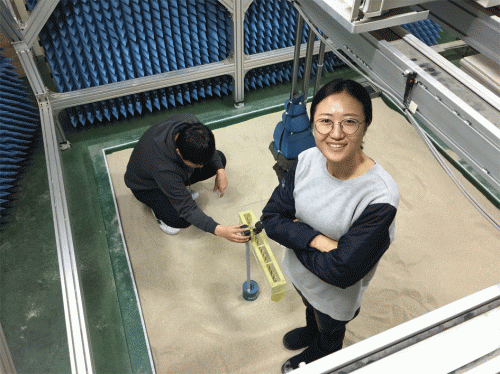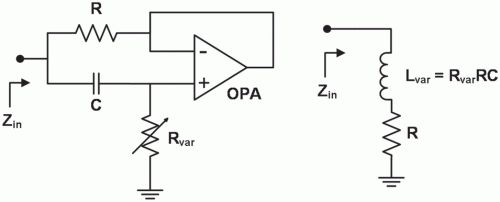Bobae Kim of the Gwangju Institute of Science and Technology. She is part of a laboratory dedicated to clearing and detecting landmines.
Collaborating researchers at the Gwangju Institute of Science and Technology and the Samsung Thales Corporation have developed a landmine detector that uses pulse induction to improve sensitivity. Their device is particularly effective for detecting deep mines, which standard metal detectors would miss due to the distortion effect of their transmitted current.
In a standard metal detector, a current is applied to the transmitter coil that induces an eddy current in the hidden metal object, which, in turn, induces a current on the receiver coil. Detection amounts to the measurement of this induced voltage. However, both the eddy current in the metal object and the applied current in the transmitter coil will induce the receiver voltage, making the measurement of this voltage difficult, as Bobae Kim, one of the authors of the research told us: "typically, the applied current in the transmitter coil causes a much higher voltage on the receiver coil than the eddy current in the nearby metal object."
Crucially, Kim explained, "in a typical MD system, the applied current in the transmitter coil is continuous, so the detector must observe the weak target voltage signal in the presence of the much higher voltage due to the applied current." To overcome this problem, pulse-induction MD systems use a pulsed applied current, which allows the voltage due to the eddy current to be observed separately in time.
Pulse-induced MD systems may improve accuracy but do suffer from other, more subtle, problems. To amplify the received (late-time) signal, the coil voltage is amplified with a large gain. However, the transmitted (early-time) signal will also be amplified by this gain, which can lead to saturation in the coil, even when there is no target present.
Another problem is that if a large voltage is received from a large target near the coil, its amplified voltage may exceed the operation range of the amplifier, causing long-term saturation. These effects mean that the received voltage may not be recovered accurately enough for target classification.
The gyrator circuit (left) and its LR equivalent (right) to eliminate saturation in the detector
Overcoming the saturation issue has proved problematic, but the collaborating team have devised a gyrator method to cancel out the applied current and so remove the early-time signal. The first step was to observe that the early-time signal decays exponentially, which is also the natural response of an inductor-resistor (LR) circuit. Therefore, to subtract the early-time signal, a circuit exhibiting the same response can be used – a time-domain bucking circuit.
In order to make a time-domain bucking circuit, an actual inductor and resistor will generally suffice. However, explained Kim, "in pulse-induction MD systems, the equivalent LR values vary depending on the coil conditions, such as temperature, but implementing the time-domain bucking circuit using a gyrator allows one to tune the LR values in real time, so the early-time signal can be subtracted in a much simpler manner."
The real time tuning is achieved by manually adjusting the variable resistor of the gyrator. However, in the near future, a single search coil will be automatically calibrated to detect deeply buried landmines in a hand-held metal detector. This means, said Kim, "that in the long term, a highly sensitive metal detector array will be applied to clear a wide area of a landmine field."
The research reported in their Letter is one of several projects the group is involved with concerning mine detection and clearance. "Our laboratory", said Kim, "is focused on landmine detection technologies, such as ground-penetrating radar, electromagnetic induction (metal detector), and nuclear quadrupole resonance." Their goal, she said, is to develop advanced multi-modal landmine detection systems. However, "the system will be primarily based on the metal detector because it is the fastest and most sensitive means to detect landmines among the available technologies."
More information:
"Pulse-induction metal detector with time-domain bucking circuit for landmine detection." Electronics Letters, Volume 51, Issue 2, 22 January 2015, page 128
DOI: 10.1049/el.2014.4515 , Print ISSN 0013-5194, Online ISSN 1350-911X
Journal information: Electronics Letters
Provided by Institution of Engineering and Technology
This story is published courtesy of Electronics Letters. For additional Electronics Letters news and features visit theiet.org/eletters.






















